| WAGR C class | |||||||||||||||||||||||||
|---|---|---|---|---|---|---|---|---|---|---|---|---|---|---|---|---|---|---|---|---|---|---|---|---|---|
 | |||||||||||||||||||||||||
| |||||||||||||||||||||||||
| |||||||||||||||||||||||||
| |||||||||||||||||||||||||
| |||||||||||||||||||||||||
The WAGR C class was a class of light axle load steam locomotives operated by the Western Australian Government Railways (WAGR) between 1902 and 1961. A total of 22 were built in two batches. [1]
| WAGR C class | |||||||||||||||||||||||||
|---|---|---|---|---|---|---|---|---|---|---|---|---|---|---|---|---|---|---|---|---|---|---|---|---|---|
 | |||||||||||||||||||||||||
| |||||||||||||||||||||||||
| |||||||||||||||||||||||||
| |||||||||||||||||||||||||
| |||||||||||||||||||||||||
The WAGR C class was a class of light axle load steam locomotives operated by the Western Australian Government Railways (WAGR) between 1902 and 1961. A total of 22 were built in two batches. [1]
The first batch of 12 engines was built by Baldwin Locomotive Works, Philadelphia in 1902. This batch was originally of a 4-6-0 wheel arrangement, and was a lighter version of the Ec class, gaining them the Baby Yanks nickname. Between 1908 and 1918 these were fitted with larger, improved boilers and converted to a 4-6-2 configuration. A second batch of 10 engines was built by the WAGR's Midland Railway Workshops in 1915, to the modified 4-6-2 design. [2] [3]
They entered service on mixed passenger and mail services on the Eastern, Eastern Goldfields and Great Southern lines. They later operated on the Northern and South Western lines. [3]
Seventeen members of the class were later fitted with superheaters and reclassified as the Cs class with the first completed in June 1929. In the 1940s, five received new frames. Four of these, Cs270 Black Butt , Cs432 Marri, Cs439 Banksia and Cs440 Jarrah were transferred to the Railway Department Sawmill at Banksiadale in the early 1950s and named. All were included in the sale of the timber mill to Hawker Siddeley Building Supplies in October 1961. After being replaced by road transport, all were scrapped at Subiaco in June 1964. [1] [3] [4]
The C class designation was previously used for the C class locomotives that were withdrawn in 1902. It was reused in the 1960s when the C class diesel locomotives entered service.

The WAGR E class were a class of 4-6-2 steam locomotives built for the Western Australian Government Railways (WAGR) by English manufacturers Nasmyth, Wilson & Co, Vulcan Foundry and North British Locomotive Company, from 1902. The locomotives provided a huge increase in locomotive power available to the WAGR and were the mainstay traction of WAGR passenger services for two decades. The Es class was the name given to a reconstruction of all but four of the class carried out between 1924 and 1925.

The WAGR D class was a class of 4-6-4T tank locomotive operated by the Western Australian Government Railways (WAGR) between 1912 and 1964.

The WAGR Dm class was a class of 4-6-4T tank locomotive operated by the Western Australian Government Railways (WAGR) between 1945 and 1971.
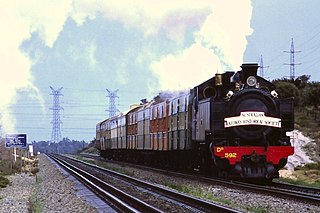
The WAGR Dd class was a class of 4-6-4T tank locomotive operated by the Western Australian Government Railways (WAGR) between 1946 and 1972.
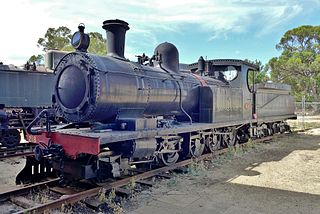
The Western Australian Government Railways (WAGR) O Class was a class consisting of fifty-six 2-8-0 steam locomotives which were introduced by the WAGR between 1896 and 1912. Despite them being tender locomotives, they also featured short boiler side tanks for additional water storage. A useful feature for the long distances required by operation on Western Australia's country lines.
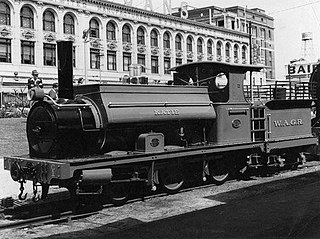
The WAGR C Class was a class of steam locomotives built by Robert Stephenson and Company for the Western Australian Government Railways in 1880 to the same design as the NZR F class.

The WAGR S class was a class of 4-8-2 steam locomotives built by the Midland Railway Workshops between 1943 and 1947 and operated by the Western Australian Government Railways (WAGR).

The WAGR P and Pr classes were two classes of 4-6-2 steam locomotives designed for express passenger service on the Western Australian Government Railways mainline network. The initial designs were prepared by E.S. Race and together the two classes had a total build number of thirty-five locomotives, the P and Pr classes entering service in 1924 and 1938 respectively. Both classes were used on express passenger services, greatly improving the economy and speed of long-distance passenger travel in Western Australia, the results of which were most visible on the Western Australian stage of the Trans-Australian Railway and Westland Express.
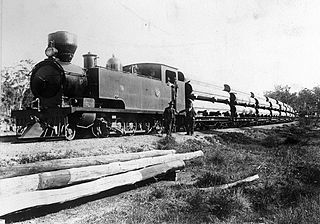
The K-class was a class of 2-8-4T steam locomotives of the Western Australian Government Railways
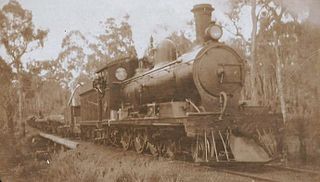
The WAGR J class was a three-member class of 4-6-0 steam locomotives operated by the Western Australian Government Railways (WAGR) between 1892 and 1924 before seeing further use with the State Saw Mills until the early 1930s.

The WAGR Q class was a six-member class of 4-6-2T tank engine steam locomotives operated by the Western Australian Government Railways (WAGR) between 1896 and 1925.

The WAGR U class was a class of 4-6-2 steam locomotives operated by the Western Australian Government Railways (WAGR) between 1946 and the late 1960s. One was rebuilt as a 4-6-4 tank locomotive.

The WAGR Pm and Pmr classes were two classes of 4-6-2 tender engine steam locomotives operated by the Western Australian Government Railways (WAGR) between 1950 and the early 1970s.

The WAGR F class was a class of 4-8-0 heavy goods steam locomotives operated by the Western Australian Government Railways (WAGR) between 1902 and 1970.

The WAGR Ec class was a class of 4-6-2 heavy passenger and goods Vauclain compound locomotives operated by the Western Australian Government Railways (WAGR) between 1901 and 1958.

The WAGR E class was a two-member class of 2-4-4-2T double-Fairlie locomotives operated by the Western Australian Government Railways (WAGR) between 1881 and 1892.

The WAGR M class was a class of 2-6-0+0-6-2 Garratt-type articulated steam locomotives operated by the Western Australian Government Railways (WAGR) between 1912 and 1955. A total of 13 of them were built by Beyer, Peacock & Co, Manchester in two batches.

The WAGR T class was a class of 4-4-0 steam locomotives operated by the Great Southern Railway (GSR) and later Western Australian Government Railways (WAGR).

The WAGR G class is a class of steam locomotives operated by the Western Australian Government Railways (WAGR) from 1889. The class's wheel arrangement varied; the first 24 were 2-6-0s and the last 24 4-6-0s.

The WAGR A class was a class of 2-6-0 steam locomotives designed by Beyer, Peacock & Co and operated by the Western Australian Government Railways (WAGR) between 1881 and 1955.
![]() Media related to WAGR C class at Wikimedia Commons
Media related to WAGR C class at Wikimedia Commons